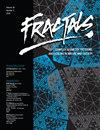一种新的基于非线性统计特征的心电信号分类系统
IF 2.9
3区 数学
Q1 MATHEMATICS, INTERDISCIPLINARY APPLICATIONS
Fractals-Complex Geometry Patterns and Scaling in Nature and Society
Pub Date : 2023-08-31
DOI:10.1142/s0218348x23500962
引用次数: 0
摘要
临床医学迫切需要对医学信号进行准确的分类。本文旨在创建一个分类器,以缩短分类时间并确保分类准确性,从而帮助医生节省诊断时间和制定治疗计划。我们基于Kolmogorov复杂度、Shannon熵、Higuchi的Hurst指数和多重分形特征创建了分类器。我们从Kolmogorov复杂度、Shannon熵和Higuchi的Hurst指数中获得一个特征值,并基于多重分形特征获得三个特征值来组成一个向量并对其进行分析。此外,我们还研究了一个由六个多重分形特征组成的向量作为对照组。利用支持向量机(SVM)将心电图(ECG)和脑电图(EEG)信号用于检测分类器的性能。基于混合分类(MC–ECG–SVM)的ECG信号的准确率达到94.17%,比仅基于多重分形特征分类(UC–ECG–SVM)的ECG信息的准确率高出约15%。MC–ECG–SVM和UC–ECG–SVM的敏感性分别为86.09%和64.54%。MC–ECG–SVM和UC–ECG–SVM的特异性分别为98.26%和93.65%。类似地,基于混合分类(MC–EEG–SVM)的EEG信号的准确性、敏感性和特异性分别达到95.29%、96.28%和94.55%。基于多重分形特征分类(UC–EEG–SVM)的EEG信号的准确性、敏感性和特异性分别为87.40%、89.28%和88.11%。因此,混合分类方法比仅基于多重分形特征的分类方法更准确。本文章由计算机程序翻译,如有差异,请以英文原文为准。
A NOVEL ECG AND EEG CLASSIFICATION SYSTEM BASED ON NONLINEAR STATISTICAL FEATURES
Accurate classification of the medical signals is urgently needed in clinical medicine. This paper aims to create a classifier to shorten the time of the classification and ensure the sorting accuracy, which assists physicians in saving diagnostic time and formulating the treatment plans. We create the classifier based on Kolmogorov complexity, Shannon entropy, Higuchi’s Hurst exponent and multifractal features. We obtain a feature value from Kolmogorov complexity, Shannon entropy and Higuchi’s Hurst exponent, and three feature values based on multifractal features to compose a vector and analyze it. Furthermore, we study a vector composed of six multifractal features as a control group. Electrocardiogram (ECG) and electroencephalogram (EEG) signals are applied to examine the performance of the classifier by support vector machine (SVM). The accuracy of ECG signals based on mixed classification (MC–ECG–SVM) reaches 94.17%, which is approximately 15% higher than that of ECG signals only based on multifractal features classification (UC–ECG–SVM). The sensitivities of MC–ECG–SVM and UC–ECG–SVM are 86.09% and 64.54%, respectively. The specificities of MC–ECG–SVM and UC–ECG–SVM are 98.26% and 93.65%, respectively. Analogously, the accuracy, sensitivity, and specificity of EEG signals based on mixed classification (MC–EEG–SVM) reach 95.29%, 96.28%, and 94.55%, respectively. The accuracy, sensitivity, and specificity of EEG signals based on multifractal features classification (UC–EEG–SVM) are 87.40%, 89.28%, and 88.11%, respectively. Therefore, the mixed classification method is more accurate than the classification method only based on multifractal features.
求助全文
通过发布文献求助,成功后即可免费获取论文全文。
去求助
来源期刊
CiteScore
7.40
自引率
23.40%
发文量
319
审稿时长
>12 weeks
期刊介绍:
The investigation of phenomena involving complex geometry, patterns and scaling has gone through a spectacular development and applications in the past decades. For this relatively short time, geometrical and/or temporal scaling have been shown to represent the common aspects of many processes occurring in an unusually diverse range of fields including physics, mathematics, biology, chemistry, economics, engineering and technology, and human behavior. As a rule, the complex nature of a phenomenon is manifested in the underlying intricate geometry which in most of the cases can be described in terms of objects with non-integer (fractal) dimension. In other cases, the distribution of events in time or various other quantities show specific scaling behavior, thus providing a better understanding of the relevant factors determining the given processes.
Using fractal geometry and scaling as a language in the related theoretical, numerical and experimental investigations, it has been possible to get a deeper insight into previously intractable problems. Among many others, a better understanding of growth phenomena, turbulence, iterative functions, colloidal aggregation, biological pattern formation, stock markets and inhomogeneous materials has emerged through the application of such concepts as scale invariance, self-affinity and multifractality.
The main challenge of the journal devoted exclusively to the above kinds of phenomena lies in its interdisciplinary nature; it is our commitment to bring together the most recent developments in these fields so that a fruitful interaction of various approaches and scientific views on complex spatial and temporal behaviors in both nature and society could take place.

 求助内容:
求助内容: 应助结果提醒方式:
应助结果提醒方式:


